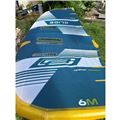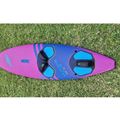4:03 AM Fri 28 Oct 2011 GMT

|
|
'4G Radar'
.
|
It won't fit on a 25ft boat, but the technology is amazing. Marine electronics leaders B&G, Simrad Yachting and Lowrance are pleased to announce the arrival of Broadband 4G? Radar. From the same family as the BR24 and the pioneering Broadband 3G?, this ground breaking FMCW technology radar is set to change the way you navigate for good. (See below for how the new technology works)
As with Broadband 3G, this new 4G radar has all the features FMCW technology brings, and so much more including:
? Unmatched resolution
? A crystal clear image
? Extremely low emissions
? InstantOn Technology
? Low power consumption
? Incredible Ease of Use - Auto Clarity
? Quick, simple Installation
Forget everything you thought you knew about radar, the Broadband 4G? Radar reinvents the standard thanks to Beam Sharpening, Target Separation Control, Dual Range Radar, and High revolution speed - features that will transform the way you navigate for good.
Beam Sharpening
- Broadband 4G is the first dome radar in the world to use beam sharpening. This technology significantly improves the azimuth resolution - or effective horizontal beamwidth of the radar providing the best target resolution of any dome radar available.
Target Separation Control*
-this feature allows the user to adjust the levels of target separation according to their needs and , thanks to Beam Sharpening, can provide resolution up to the equivalent of a three and a half foot open array radar.
* Currently available with Simrad NSE, other MFDs will have future functionality
Dual Range Radar
- When combined with the Simrad NSE, Broadband 4G? has the capability to display dual range radar combinations from a single scanner, and allows boaters to benefit from revolution speeds up to 48rpm.
No other recreational radar in the world can display dual range from 200 feet to 36nm in a single dome. Now you can monitor a buoy 200 feet away and keep track of coastal projections at 36nm at the same time, for the ultimate in navigational safety.
Advances in FMCW technology now mean that the Broadband 4G is as competitive at distance as it is at close range. When combined with the latest multifunctiondisplay units from Simrad Yachting, B&G and Lowrance, Broadband 4G? Radar offers an unrivalled total of 18 working ranges that include a 36 nautical mile range for increased performance and situational awareness.
In addition, Broadband 4G Dual Range operation allows up to 10 MARPA targets in each split radar screen with independent controls - for a total of 20 tracked targets.
Conventional pulse radar is limited to showing targets that are about 80 feet (24m) or more away, whereas Broadband Radar is able to see targets right up to the bow of your boat. It's worth remembering that 100% of all boat collisions occur within this conventional radar'blind spot.'
Broadband 4G? also benefits from unrivalled clutter reduction with Directional Sidelobe Clutter Suppression for large targets and improved sea clutter rejection, which allows target clarity at a glance even in high sea states.
Pre-defined Offshore and Harbour modes provide hands-off operation on all ranges without the need for special knowledge or radar tuning, giving the boater all the confidence of a highly trained radar user.
Unlike any other conventional radar available today, the Broadband 4G? emits less than one fifth of the radiation of a mobile phone and is safe at any distance. And thanks to InstantOn technology, Broadband 4G is always ready for action with no warm up time.
When combined with enviable range and the best resolution of any radome on the market, the Broadband 4G marks the birth of a revolution and the death of the magnetron pulse radar.
Broadband 4GTM Radar systems should be available from your local dealer in Late November.
.........................
How does it work? - Broadband Radar? compared to conventional pulse radar:
The dual microwave stripline arrays inside of the antenna dome allow continuous transmission and reception, unlike
conventional radar that only has one antenna used for both.
An example of Main Bang interference on a 4kw radar screen Conventional pulse radar uses a magnetron to generate a pulsed microwave signal that is transmitted from the rotating radar antenna. This 'bang' of microwave energy is re?ected o! targets that it hits and returns to the radar, the time it takes determines the range and bearing.
This type of radar transmission is, in layman's terms like shouting loudly in one direction and then listening to see if you hear an echo, turning your position and then repeating the process.
Broadband Radar uses a di!erent type of technology, allowing the radar to send out a continuous radar signal. The continuous signal has a changing tone or frequency (at a much lower power than a pulse radar) and the Broadband Radar constantly listens for the change in that signal. This is more like you whispering a tune continuously and listening at the same time for the echo. This is made possible by using two antennas, one which whispers and one that listens.
The change in the tone of the transmitted radar signal (or in our example the notes of the tune) determines the time taken for the signal to reach the target and return. This time determines the range and the bearing.
Broadband Radar simultaneously receives as it transmits, unlike a pulse radar that pulses loudly then has to switch the internal circuits from transmit to receive. This causes all pulse radars to have an unavoidable 'main bang' which appears in the centre of the screen as a sunburst. This covers up any close targets, reducing the e!ectiveness of the pulse radar at short range.
Many types of pulse radar 'blank' this main bang arti?cially this also hides any short-range targets which blinds the radar to close by targets. With Broadband Radar only sending out a 'whisper' the main bang is just not there, so there is no sunburst in the centre of the screen and no need for main bang suppression. The bene?t of this is that close targets are not lost or hidden, with the radar able to show targets right up to the bow of the boat. This short-range performance is exclusive to Broadband Radar.
Conventional radar emits a pulse, and this pulse varies in length depending on the range. This pulse length determines the ability of the radar to distinguish between close targets on a similar bearing. Usually this can be around 80ft at short ranges and up to 500ft at longer ranges. Broadband Radar, using a continuously transmitted signal, is able to see targets as close as 6ft from the dome on the shortest scale and separate targets 30ft apart in range on the scales used for navigation.
This short-range performance is also enhanced with the minimum range scales now going beyond the conventional 1/8 th of a nm range down to just 200ft with three additional scales. With Broadband 4G? Radar including an additional 36nm long range scale, there are 18 range scales now available.
by Des Ryan
|







